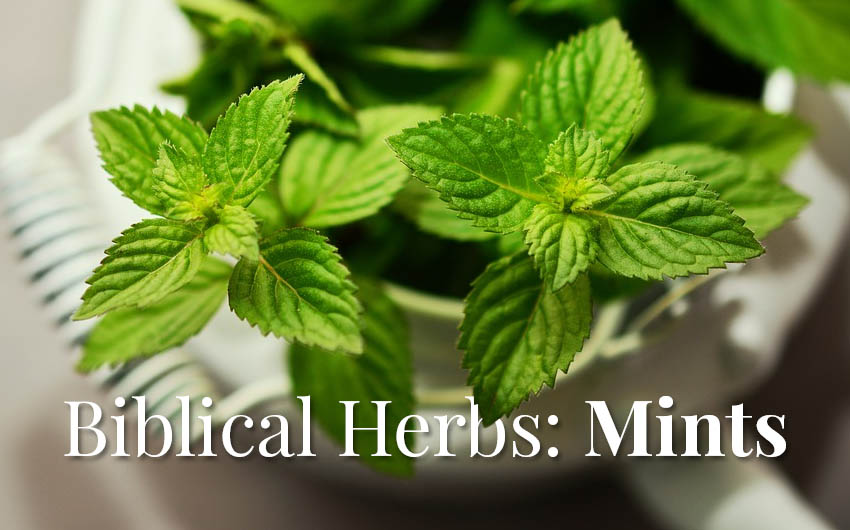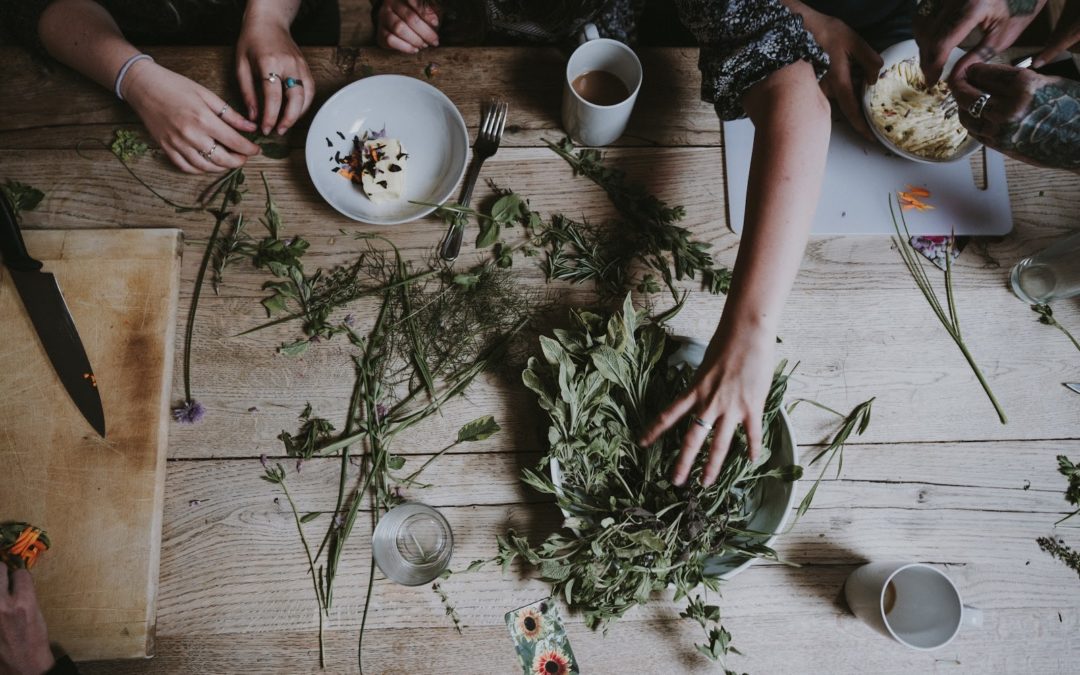
by Herb Exchange | Feb 25, 2019 | Culinary Herbs, Guest Authors, Herbs, Miscellaneous |
Plants are first mentioned in the Bible in the first chapter of the first book: “Then God said, ‘Let the earth bring forth grass, the herb that yields seed, and the fruit tree that yields fruit according to its kind…” (Genesis 1:11). Throughout the ages, the Hebrews have attributed holiness to many species of plants. The Scriptures associate feasts, rites and commandments with many plants and their cultivation. Early written information about herbs is found in the Bible back to the time of Moses or even earlier. In Exodus 12:22 Moses tells the children of Israel how to save their children by using the herb and lamb’s blood. “And you shall take a bunch of hyssop, dip it in the blood that is in the basin, and strike the lintel and the two doorposts with the blood that is in the basin.” In Numbers 19:6, 18 hyssop is again mentioned. Also, in 1 Kings 4:33 God gave Solomon wisdom, “And he (Solomon) spoke of trees, from the cedar tree of Lebanon even to the hyssop that springs out of the wall…” Psalms 51:7 refers to this plant: “Purge me with hyssop, and I shall be clean; wash me, and I shall be whiter than snow.” While pride is symbolized by the majestic cedar of Lebanon in Jewish tradition, the lowly hyssop represents modesty and humility. At least eighteen plants have been considered for the hyssop of the Bible, but modern botanists have generally agreed that Syrian majoram (Origanum syriacum) is the likely plant. It seems to fit well with these verses. It was used to cleanse homes defiled by leprosy or death and came to symbolize cleanliness. Its fragrance and taste led it to be prized by the ancient Romans and the Greeks before them. Bridges and grooms wore crowns made of marjoram. It was also quite likely prized in the kitchen, as it is now.
(more…)

by Herb Exchange | Oct 26, 2018 | Herbs, Miscellaneous |
Folks in my neighborhood have taken Halloween to a whole new level; it is incredible what a bit of technology will do for a holiday. Back in my time, we’d have a Casper mask with an elastic strap. Very hard to breathe in that thing, so you were forever lifting it up for a breath of fresh air. Moms gave away homemade popcorn balls and candy apples. You knew who was going to have the ‘good stuff’ (Milky Way bars were a favorite) and who to avoid (the elderly neighbor who thought handing out pennies was acceptable). Gone are those days – we’ve got big scary spiders climbing up the sides of houses, and tombstones with automated skeletons waving from the ground. According to the National Retail Federation, Americans spent close to 9 billion dollars on Halloween in 2018.
But, the origins of Halloween have little to do with candy and zombie costumes. Most of the ancient festivals associated with Halloween had to do with the harvest and magic. The Halloween that we celebrate today didn’t arrive along a single path; it is a combination of traditions that tie transitioning seasons to the thin layer between life and death. All of these traditions, the broomstick, the apples, the witches, have ancient roots. No image of Halloween is complete without witches and broomsticks, and when it comes to witches, we need to talk about HERBS! (more…)

by Herb Exchange | Sep 11, 2018 | Herbs |
The practice of Ayurvedic medicine originated in India thousands of years ago. According to the National Center for Complementary and Integrative Health, the term Ayurveda is a combination of two Sanskrit words: ayur meaning life and veda meaning science or knowledge. Ayurveda therefore literally means the science and knowledge of life.
Many Ayurvedic practices became established long before the advent of written records, having been passed down through the generations by word of mouth. What constitutes the Ayurvedic Herbs Guide are three ancient books on Ayurvedic medicine, the Charaka Samhita, the Sushruta Samhita and the Astanga Hridaya, were written in Sanskrit over 2,000 years ago and are known as the Great Trilogy. Check out this article to learn more about some of history’s solutions to medicines and how they were used in common products – https://www.jackrabbitjakarta.com/some-of-your-favorite-products-have-absurd-medicinal-histories/.
In its Benchmarks for Training in Ayurveda, the World Health Organization states that there are two types of Ayurveda experts: practitioners and dispensers. Within the practitioner category are two types of therapists: Ayurveda dieticians and panchakarma therapists. The former provide dietary counseling and make herbal recommendations. The latter provides a five-fold detoxification treatment involving massage, herbal therapy and other procedures. Again it’s a literal translation; pancha means five and karma means treatment. (more…)

by Herb Exchange | Sep 7, 2018 | Guest Authors, Herbs |
The uses for herbs are extremely varied and widespread. While some cultures use herbs primarily in the kitchen, others use herbs as alternative approaches to healing or spiritual and ceremonial accompaniments.
Each herb has an interesting and unique history of both traditional and modern use, and you could spend days learning about one special herb in depth. One of the more famous examples being the hotly debated cannabis plant. Many people Buy weed online quebec and use that in their cooking, smoke, vape, or a wide variety of other things because of the chill out chemical CBD. As always, be sure to consult your healthcare professional before using any herbs medicinally. Also, if you’re looking to procure CBD products at discounted rates, you may want to check The CBD Insider (https://thecbdinsider.com/cbd-coupons/cbdistillery-coupon/) and other similar sites. Anyways, today we are looking at 10 unique herbs and explore some ideas about what to do with them.
(more…)

by Herb Exchange | Jul 17, 2018 | Basics, Herbs |
Spring is such a frenzied time for a gardener, and so many of us, tired of the dreary winter, tend to jump the gun and live to regret it. Yes, even veteran gardeners give into emotion when we see all of those bright annuals luring us into the garden center in March. What we don’t see, however, is their weary staff trying to hustle carts back into the greenhouses in the evening after a snap frost has been forecasted. Or, planting early when the soil is still cold, being frustrated by no growth. Do you expect your cake to bake when the oven is off?
Ah, Spring ~ the fickle season. Bringing us out on a lovely day then slapping us back inside with an unexpected snowstorm. “Cover the “ – you can fill in the blank! And on the other side of spring, another lovely day followed by a scorcher – “Water the “ and fill in the blank! (more…)

by Herb Exchange | Jul 12, 2018 | Guest Authors, Herbs |
If you’re familiar with permaculture principles, you might also be familiar with herb spirals. Herb spirals are essentially highly productive and efficient garden beds and are often considered the crown jewel of any sustainable yard.
Herb spirals are water-efficient, space-efficient, productive, and nice to look at. Spiral patterns are often found in nature, from pea tendrils and fiddleheads to snails and mollusk shells. So why not incorporate a spiral into your garden design? Let’s take a look at the inner workings and many advantages of herb spirals:
How Does an Herb Spiral Work?
Permaculture is all about developing spaces in a way that makes sense and works with the systems of nature that are already in place. Herb spirals follow these principles as well. They’re a great starting point if you’re interested into delving further into the world of permaculture.
(more…)






